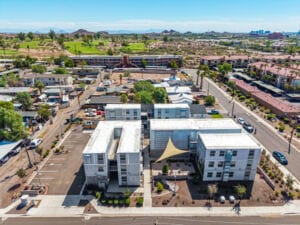As states around the country slowly begin to open their businesses, one question remains top of mind for business owners alike: what’s next for the commercial real estate market? Nationally, there have been several news sources that talk about how dismal the CRE market will be for the foreseeable future. According to Costar, “The nation’s average vacancy rate is currently 10%, a figure CoStar expects will steadily climb through mid-2023.”

While tourism and the entertainment industry has been hit hard, Arizona has seen a diversification in our business sectors – many are going strong. Vacancy rates in all commercial real estate sectors were at an all-time low prior to pandemic. What’s more, office vacancy rates were between 10 percent and 12 percent during the 2008 Great Recession and rose to 30 percent valley-wide. Today, amid the pandemic, Costar projects office vacancy rates between 11 percent and 15 percent.
Arizona will continue to sustain manageable vacancy rates in office and industrial post-pandemic for these reasons:
1. For the first time, Arizona is not overbuilt with spec office space. Much of the construction is spoken for and there are minimal spec buildings in process. Compare this to 2008 Great Recession when spec buildings in the cue were at an all-time high.
2. Some companies will discover they need more space due to the “new norm” defined by OSCHA and HR standards
3. Call centers will either split shifts or expand their footprint if cubicles are too close for employee personal comfort or CDC recommendations. During the transition period sneeze shields and upgraded filtering systems could be put in place.
4. Businesses that need additional space, will absorb space that other companies release to the landlord. Smaller business with individual offices may not feel any change in the work environment other than government-mandated health signs in the workplace. It’s important to note that tenant diversity is high right now, which supports greater sustainability.
5. Rental rates may equalize. Landlords with no debt, lower debt, or agreeable lenders will do what is necessary to keep their buildings at high occupancy. They’ll offer incentives to attract renters. This will cause a domino effect on office rental rates as landlords compete for tenants. Like we saw in the Great Recession, landlords with inflexible lenders will not be able to adjust to these new rental rates and will probably lose their buildings.
6. For flexible tenants, this presents a good time for companies to negotiate an advantageous lease. Already landlords are open to shorter-term leases if minimal upfront capital is required from the landlord.

7. Working from home doesn’t work for every company and has shortcomings. Synergy and creative inspiration are two of the big drawbacks. Humans desire the company of others and need a break from the home routine.
8. Many businesses are on “hold” who need office and industrial space. It feels the pent-up demand for space will be absorbed quickly further reducing office choices for renters.
As we wait to see what happens next, I suspect Arizona will come out of the pandemic above other major cities for reasons including our geographic location, our “dry heat”, plethora of land for development, low building footprints and nationwide stats that show we managed the outbreak well.
It’s important that companies use this time to focus on the next “pandemic.” Those companies who create a plan now with workspace, renegotiated rent terms and a readiness plan, will come out ahead down the road.
Andrea Davis, CCIM, has practiced commercial real estate for over twenty years. Davis’s breadth of knowledge stretches from developers to landlords to buyer/tenant representation and investments. Within the commercial real estate industry, Davis has won numerous awards. The Phoenix Business Journal ranked Andrea Davis CRE in the top 10 of Ranking Arizona for the category of Office Brokerage. Her book, SimpLEASEity™, focuses on leasing and is the first in a series of commercial real estate guidebooks. Her next book, Simply Own It, the American Dream, is forthcoming this year.



